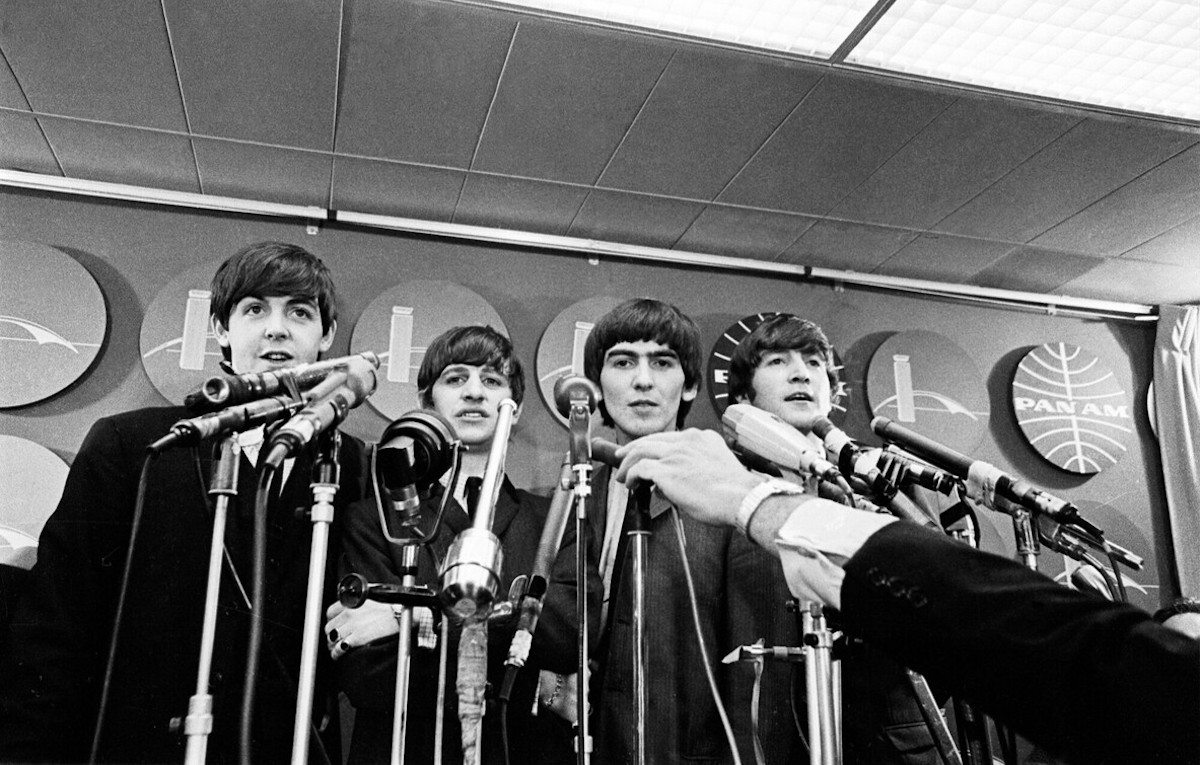Strange, but true: in the 1960s the Beatles' American record company decided not to release the albums as they were intended, preferring to dismember them to create more products. They had no idea in the Capitol offices that future generations would idolize those records as sacred works of art. They just wanted to squeeze as much money out of those long-haired guys as possible before the bubble burst. And so they put 12 songs on each LP, instead of 14, releasing seven records in a year, with the result that American fans heard different versions of those albums than the rest of the world. Versions that were then forgotten, but which constitute a fundamental part of the Beatles saga: they are the LPs that made America fall madly in love with the Fab Four.
Now those records are about to be reissued in the box set The Beatles: 1964 US Albums in Mono which collects the first seven American LPs on Capitol, all released between January 1964 and March 1965, re-released on November 22nd on 180 gram vinyl for audiophiles.
After having exploded in Europe, Beatlemania exploded in the United States on February 9, 1964, the day in which John, Paul, George and Ringo performed atEd Sullivan Show. The album that was in American stores at the time was Meet The Beatlesa hodgepodge of singles, B-sides and tracks from various LPs. Capitol was convinced they had to raise money since everyone thought those guys would last a year, two at most, and so they published one after the other Meet The Beatles, The Beatles' Second Album, A Hard Day's Night, Something New, The Beatles' Story, Beatles '65 And The Early Beatles.
The new versions sound phenomenal in mono exactly as they were intended. The transfer to vinyl was supervised by Kevin Reeves at the East Iris Studios in Nashville, the box set collects the seven US albums (also available individually, except for the 33 rpm documentary cut The Beatles' Story). The box is accompanied by liner notes by Bruce Spizer, illustrious Beatles historian, and the new mixes finally do justice to the American tapes. As Reeves says, “they wanted to not only release these unique records, which hadn't been released on vinyl for a long time, but they wanted to try to do something to renew them.”
Entire generations of Americans grew up listening to them. Fans have become passionate about titles like Yesterday… and Today And Beatles VI which did not exist in the UK. Every single LP before Sgt. Pepper was mangled (the Revolvers American was missing three of John's best songs). It seems incredible, but the Beatles' original English albums weren't released in America until 1987, when the much-hyped CD versions arrived. Meanwhile, US LPs have disappeared from circulation and have been out of print since 1995: most fans today have never heard them.
Yet, in many ways, the US albums were even more influential than the “real” ones. They're the records the Beach Boys listened to. The ones Smokey Robinson listened to. The ones that Stevie Wonder, Carole King and Marvin Gaye took as an artistic challenge. Bob Dylan discovered the Beatles by listening to stuff like Something New. When Brian Wilson heard Rubber Soul and decided that he would outclass it with Pet Soundswas listening to the Rubber Soul wrong (Brian's copy started with I've Just Seen a Facenot with Drive My Car).
The Beatles refused to include singles on LPs, they believed it wasn't fair to charge fans twice for the same song. And so, as a matter of principle, in the UK 45s like I Want to Hold Your Hand And She Loves You they were left out of the LPs. Capitol, on the other hand, had no scruples, probably rightly so: American fans would have rioted if they had bought Meet the Beatles without finding us I Want to Hold Your Hand.
Here, take it Meet the Beatles: leaves with I Want to Hold Your Hand (a single), I Saw Her Standing There (the opening piece of Please Please Me), This Boy (the back of All My Loving) And It Won't Be Long (the first song of With the Beatles). You could say it's a betrayal of the band's artistic intentions, that it's a mix-up, maybe even a mystification, but it's still a killer A-side. Meet the Beatles it's the classic that the Beatles never conceived.
The US albums were assembled by a man called Dave Dexter, the Capitol record executive who handled the Beatles' releases. He is a controversial figure in the history of the Fab Four, who fans tend to curse. He was a jazz fan who didn't like the Beatles and thought their records weren't very good. So he remastered them. «He didn't want to publish them», explains Reeves, «but the record company forced him to do so and he thought it best to get involved and make them different by making changes to what had been done in the United Kingdom». He was heavy-handed in the studio: «I don't want to be too critical, but he made some bizarre choices».
That's why some sound issues had to be addressed for the new edition of the US albums. “Dexter radically changed some things,” Reeves says. “First, he took the stereo reels and made them mono. He compressed everything. He definitely used Capitol's beautiful echo chambers to improve the sound a little.” Putting it that way is an understatement, because Dexter mixes are well known for added echo, especially in Beatles '65: When George sings Everybody's Trying to Be My Babywallows in the reverb. “It looks like it's inside the Lincoln Tunnel,” jokes Reeves.
How was it possible that only one person intervened on albums like those, which were quite important? “Doesn't that sound like a typical New Jersey boss move to you?” asks Reeves. “That guy must have had some Jersey in him. Was he a genius or a scoundrel? I don't know, it's usually perceived the second way, because he took those wonderful, pure-sounding Abbey Road tapes and turned them into something completely different.”

The Beatles answer journalists' questions at JFK in New York. Photo: Apple Corps Ltd
The US pressings were also infamous for the terrible fake stereo effect. “We always called it pseudo stereo,” Reeves says. «It's easy to transform a mono recording into a pseudo-stereo: just equalize it in two very different ways and it seems that what comes out of each channel is different. But it's not the best.”
Many fans accused Dexter of being a jazz snob who hated rock'n'roll and sabotaged those albums out of spite. “I can't speak reliably about it, but there are some clues that might suggest it's true,” Reeves says. “He didn't skimp on sending out his famous memos saying that this stuff wouldn't sell and would only appeal to kids who listened to music on five-dollar record players, or that the records looked like they were printed on the backs of cereal boxes. He was very direct.”
The challenge of The Beatles: 1964 US Albums in Mono it was to take the American tapes and finally make them sound like the Beatles. “We wondered which coils to use,” explains Reeves. «The ones from Dexter or the ones from Abbey Road? We took the tapes, not copies, nor pseudo-stereo versions. And that's where we got the vinyl from.”
American albums have their own distinct personality. Second Album has a cult following, with the Beatles paying homage to their African-American heroes by covering Little Richard, Chuck Berry and Motown. A Hard Day's Night it was a half-rip, filled as it was with George Martin's orchestral versions of Beatles songs. The Early Beatles it's basically his debut English LP Please Please Mewhich Capitol had not published. Something New And Beatles '65 (released mid-December 1964) present the darker side of John and Paul, with songs A Hard Day's Night And Beatles for Sale.
The Beatles Story is a bizarre document, with voiceovers telling the band's story along with interviews, press conferences, dialogues and fragments of songs. It's a double album of less than 50 minutes and yet it made the Top 10: not bad for a record that doesn't even have a complete song. It is a tribute to Capitol's total shamelessness, which led to the closure of the otherwise impeccable Something New with a German version of the band's first US hit: Komm Gib Mir Deine Hand.
The Beatles: 1964 US Albums in Mono represents redemption for these long-neglected LPs: they finally sound magnificently good, albeit in their own way. It would have been easier to use the Abbey Road mixes to recreate the American versions but, as Reeves explains, «we wanted to release unique records, which hadn't been released on vinyl for a while, and we wanted to try to do something to renew them. I let the tapes “breathe” so they could come to life and express their nature: I hope the fans will appreciate it.”
From Rolling Stone US.

